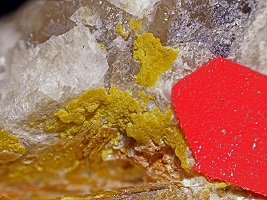
Locality: Government Pit, Albany, NH
Confidence: 5
Chemistry: Fe2+(C2O4) · 2H2O
Specimen Size: 7.5 mm field of view.
Field Collected: Leroy Grant
Catalog No.: 2138
Notes: Humboldtine confirmed by EDS analysis, (polished grain) and Raman analysis.
Red arrow points to sample point for EDS analysis grain. A second EDS analysis, high count, carbon tape mount, from another grain indicated a humboldtine - K feldspar mix. This carbon tape analysis is more likely to have surface contamination than the polished grain analysis.

Locality: Government Pit, Albany, NH
Specimen Size: 10 mm field of view
Field Collected: Leroy Grant
Catalog No.: 2138
Notes: Crusty orange humboldtine on feldspar matrix. Source specimen for EDS analysis.
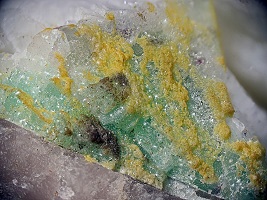
Locality: Government Pit, Albany, NH
Specimen Size: 1.2 cm field of view
Field Collected: Leroy Grant
Catalog No.: 2151
Notes:
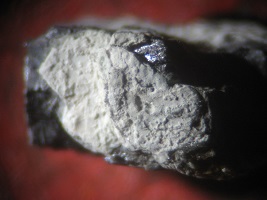
Confidence: 3
Chemistry: 3PbO · H2O
Locality: Johnson Rd., Bow, NH
Specimen Size: 9 mm field of view.
Field Collected: 2016
Catalog No.: u2136
Notes: Perhaps hydroplumbite, a hydrated lead oxide, the only Pb oxide that is white. This powdery white unknown has shown up on several specimens. It appears to be an weathering product of galena. This small chunk is solid galena, except for this powdery crust. I cannot find any photos of hydroplumbite. Mindat has it as "Approved, grandfathered, questionable." It is not listed in my 2008 Fleisher's.
Tests: Not fluorescent. Not soluble in water or muriatic acid.
A carbon tape grain EDS analyses (BC286 - set 19) indicated a lead mineral with oxygen. Unfortunately, the EDS did not resolve an ambiguity of lead and sulfur, so the possibility of powdered anglesite cannot be eliminated. The tiny bit of aluminum in the plot is likely a contaminant.
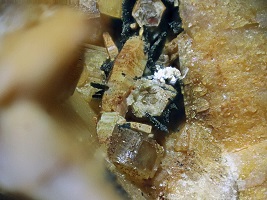
Locality: Water Pocket Locality, Albany, NH
Confidence: 3
Chemistry: Ca(Ce,La)(CO3)2(OH)
Specimen Size: 4 mm field of view
Field Collected: Bob Wilken - 8/29/17
Catalog No.: u2293
Notes: A January 2020 polished grain EDS analysis [bw WPV13] suggested hydrosynchysite-(Ce). No fluorine was detected (at 0.677 KeV). The unlabeled peak just above the carbon is the oxygen line.
A blocky bertrandite crystal is in the lower foreground. The broken hexagonal hydrosynchysite-(Ce) crystals show zoning. The black mineral is believed to be ilmenite.
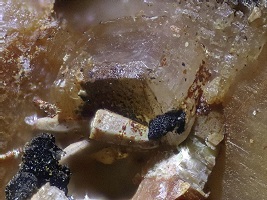
Locality: Water Pocket Locality, Albany, NH
Specimen Size: 0.4 mm brown prismatic crystal on bertrandite crystal
Field Collected: Bob Wilken - 8/29/17
Catalog No.: u2293
Notes: Another view from u2293.
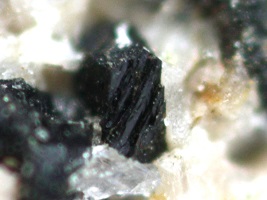
Confidence: 2
Chemistry: (Mg,Fe)SiO3
Locality: Aggregate Industries Quarry, Raymond, NH
Specimen Size: TBD
Field Collected (owner): Peter Cristofono
Notes: [PC] "Hypersthene? from monzonite. It looks to be a pyroxene based on cleavage, and if so apparently hypersthene according to Freedman (1950); However, I don't think it can be visually distinguished with certainty from augite."
[TM] Phillip Morrill did report hypersthene from New Hampshire.
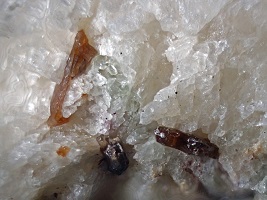
Confidence: 4
Chemistry: U4+Fe2+Nb2O8
Locality: Oliver Trench, Moat Mtn., Hale's Location, NH
Specimen Size: 3.5 mm field of view
Field Collected: Bob Janules
Catalog No.: A Bob Janules collection specimen
Notes: A Bob Janules submitted EDS analysis indicated ishikawaite.
Photo with Canon T3i, 50 mm Canon lens,1 cm extension tube, plus Nikon Plan 10 microscope objective. Helicon Focus.
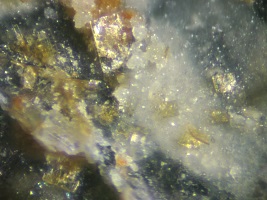
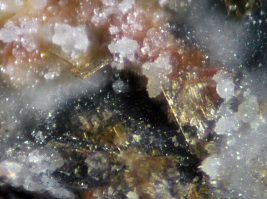
Confidence: 5
Chemistry: Fe(UO2)2(AsO4)2 · 10-12H2O
Locality: Parker Mtn. Mine, Center Strafford, NH
Specimen Size: 1 mm field of view, top photo. Tiny rectangular, paper-thin, plates of kahlerite.
Catalog No.: u2028
Field Collected: Bob Janules
Owner: Tom Mortimer
Analysis: Kahlerite confirmed by EDS analysis.
Notes: Only two Parker Mtn. kahlerite specimens are known. The other is in the collection of Dana Morong. Altering lollingite is present with scorodite on this specimen and is likely the source of the arsenic.
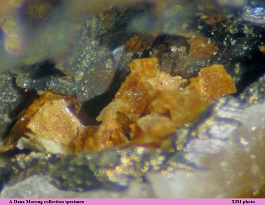
Locality: Parker Mtn. Mine, Center Strafford, NH
Specimen Size: 2 mm field of view. Kahlerite (coated?) in lollingite vug
Field Collected - Owner: Dana Morong
Catalog No.: A Dana Morong collection specimen
Notes:

Confidence: 3-4
Chemistry: Ca3MnFeAl4(PO4)6(OH)4 · 12H2O
Locality: Chickering Mine, Walpole, NH
Specimen Size: 2.3 mm field of view
Field Collected: Bob Wilken
Catalog No.: A Bob Wilken specimen & photo
Notes: A qualitative Kerry Day EDS analysis (BWilken19) showed a Al, Fe, Mn, phosphate with a LOT of Ca. Kingsmountite is chemically a reasonable fit and this Chickering specimen is a good visual match with several mindat kingsmountite photos, although none have these feathery tops. A quantitative EDS is planned.
Kevin Czaja's Mar/Apr 2025 Rocks & Minerals article on the Turner Mine, Marlow, NH, reported a confirmed presence of kingsmountite.
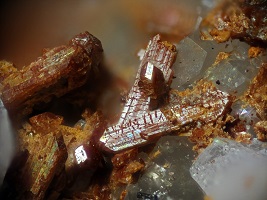
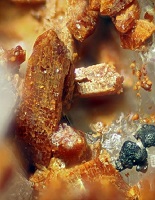
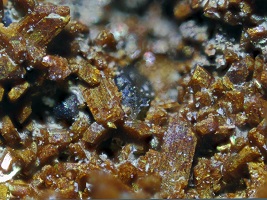
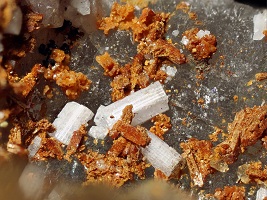
Confidence: 5
Chemistry: Fe2Al2Be(PO4)2(OH)6
Locality: Palermo Mine, Groton, NH
Specimen Size: Top photo - 1.9 mm field of view, other images as indicated.
Field Collected: Bob Janules
Catalog No.: u2115
Notes: Lefontite has been reported from the Palermo Mine, RUFF reference link . A polished grain EDS analyses compares very well with the RUFF analysis (R140539-2) for lefontite.
The chemistry from the RUFF analysis is:
(Fe1.22, Mn0.48, Ca0.16)Al1.91Be0.97P2(H2O)6.5
The chemistry from the BC225 analysis is:
(Fe1.31, Mn0.38, Ca0.28)Al1.91P2O12.1 , normalized for 2 P, (EDS cannot detect berylium).
The Mn and Ca substitutions in the RUFF analysis are present in the BC225 analysis in reasonable proportions, and the Al content is "right-on."
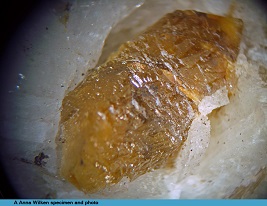
Confidence: 4
Chemistry: Mg(CO3)
Locality: Charles Davis Mine, N. Groton, NH
Specimen Size: 8 mm magnesite crystal
Field Collected: Anna Wilken
Catalog No.: An Anna Wilken collection specimen
Notes: Magnesite is an unusual species to find in a pegmatite environment. Under the scope, rhombic carbonate cleavage is observed. Bubbles formed on surface of a grain in cold muriatic acid. EDS analysis showed only magnesium, oxygen and some likely carbon, (carbon was disabled from the analysis because the polished grain was carbon coated.) The polished grain was probed in two spots and both gave the same result.
I [tm] asked Jim Nizamoff for his opinion on the magnesite identification. he replied: "I agree that magnesite in a pegmatite is pretty much unheard of. I do believe that Mg can be concentrated in small areas in the right environment though. Perhaps this is what happened at CD. There is an unusual amount of Mg in a number of the local pegmatites so you have the ability to up concentrate much more easily than pegmatites in other localities. I do find the magnesite ID a little bit questionable I but cannot refute what the EDS scan shows as I know that almost anything is possible in micro environments in pegmatites. I feel safe telling you to go with it as magnesite."
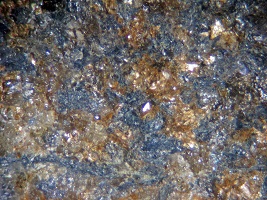
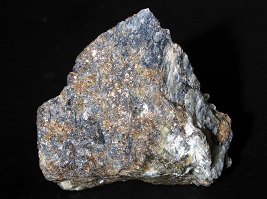
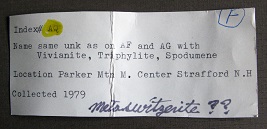
Confidence: 5
Chemistry: Mn+23(PO4)2 · 4H2O
Locality: Parker Mtn. Mine, Center Strafford, NH
Specimen Size: 8 mm field of view (top photo). Scaly golden-bronze colored metaswitzerite on triphylite
Field Collected: Gene Bearss - 1979
Owner: Tom Mortimer
Catalog No.: u1786
Analysis: A carbon tape mounted grain EDS analysis (BC36) showed only P, Mn, O and a bit of Fe.
Notes: The Bearss label with the specimen suggests metaswitzerite for this mineral. The chemistry indicated by the EDS spectrum is consistant with metaswitzerite with a bit of Fe substitution for some Mn. Mindat photos of metaswitzerite from The Foote Lithium Mine in North Carolina compare favorably with this specimen.
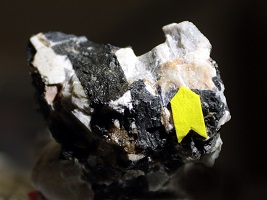
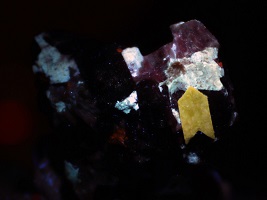
Confidence: 4
Chemistry: Na2Al2Si3O10 · 2H2O
Locality: Red Hill, Moultonborough, NH
Specimen Size: 2.3 cm specimen
Field Collected: Tom Mortimer
Catalog No.: u2735
Notes: Orangish area fluoresces white in SW UV. A George Adleman Raman analyses (top black trace) gave a very good match for natrolite, (second red trace).
Peter Cristofono commented "In nepheline syenites, sodalite and nepheline sometimes alter to a white decomposition product called "hydronephelite" or "spreustein." Mindat.org calls spruestein fine-grained natrolite that replaces sodalite or nepheline, and hydronephelite a mixture of about 80% natrolite (with a little gibbsite, etc.). In Salem. MA, the white, altered sodalite is fairly common. It fluoresces a strong white under long-wave UV, strong yellow-white under mid-wave UV, and somewhat weaker green-white under short-wave UV."
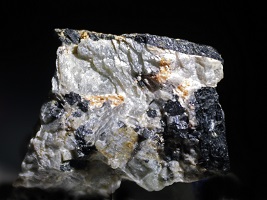
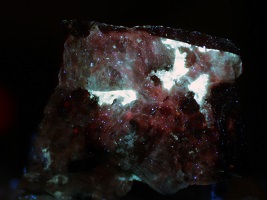
Locality: Red Hill, Moultonborough, NH
Specimen Size: 1.9 cm specimen
Field Collected: Tom Mortimer
Catalog No.: u2736
Notes: Another Natrolite var. spreustein specimen.
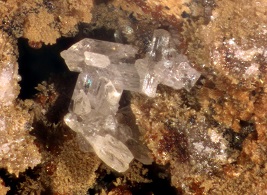
Confidence: 4
Chemistry: Mn+2Zn2(PO4)2(H2O2)4
Locality: Palermo Mine, N. Groton, NH
Specimen Size: 3 mm field of view
Field Collected - Owner: Bob Wilken
Analysis: The nizamoffite identification is suggested by EDS analysis 9/14/16.
Notes: The sodium response (not present in the described nizamoffite chemistry) is likely a miss-identification by the EDS element assignment software. Zn and Na have strong peaks separated by only 29 eV.
[tm] I question the EDS software assignment of sodium within the Zn-Na peak. Zn has two peaks in this area, one at 1.012 KeV and one at 1.035 KeV. Sodium has a strong peak at 1.041 KeV. The resolution of the instrument is 125 eV (0.125 KeV).
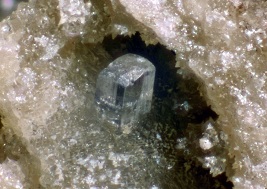
Locality: Palermo Mine, N. Groton, NH
Specimen Size: 0.5 mm nizamoffite crystal
Field Collected - Owner: Bob Wilken
Notes:

Locality: Parker Mtn. Mine, Strafford, NH
Specimen Size: 1 mm field of view. Crusty mass of orpiment-realgar on triphylite
Field Collected: Phillip Foster (#26.10=1)
Catalog No.: u2063
Notes: An article in the December, 1982 issue of "Granite Chips" newsletter of the Southeastern New Hampshire Mineral Club by Phillip Foster reports a find of two "pin-head" sized occurrences of orpiment-realgar from Parker Mtn. This is likely one of those specimens. Harvard examined the specimen, but was non-committal and indicated the sample was too small for analysis. Gunnar Bjareby opined a possible realgar-orpiment ID. The elements in realgar/orpiment are arsenic and sulfur, both of these are present at Parker. I [tm] had discounted a realgar-orpiment occurrence at Parker as "folklore." The matrix for this small crusty bleb is triphylite-ferrisicklerite and appears quite legitmate for a Parker Mtn. piece. A Parker Mtn. Mine species list authored by Art Smith, Rocks & Minerals, July/Aug, 2005, pg. 256, includes orpiment. This Art Smith list is likely responsible for the inclusion of orpiment in mindat.org's Parker Mtn. Mine species list (2015).
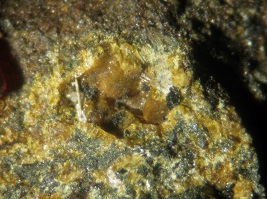
Confidence: 3
Chemistry: (Mn2+,Ca)(Mn2+,Fe2+,Mg)Fe3+(PO4)2(OH) · 4H2O
Locality: Palermo Mine, N. Groton, NH
Specimen Size: 4 mm field of view
Field Collected: Forrest Fogg
Owner: Tom Mortimer
Catalog No.: u1475
Analysis: Qualitative EDS analysis suggests this is likely a member of the overite mineral group, perhaps manganosegelerite
Notes: From material collected by Forrest Fogg in the 1970's, forwarded to me by Gordon Jackson. The color is about right based on the mindat photo for this species. No overite group minerals have been reported from Palermo. A quantitative EDS with Atomic %'s and good light element resolution would be helpful on this specimen.